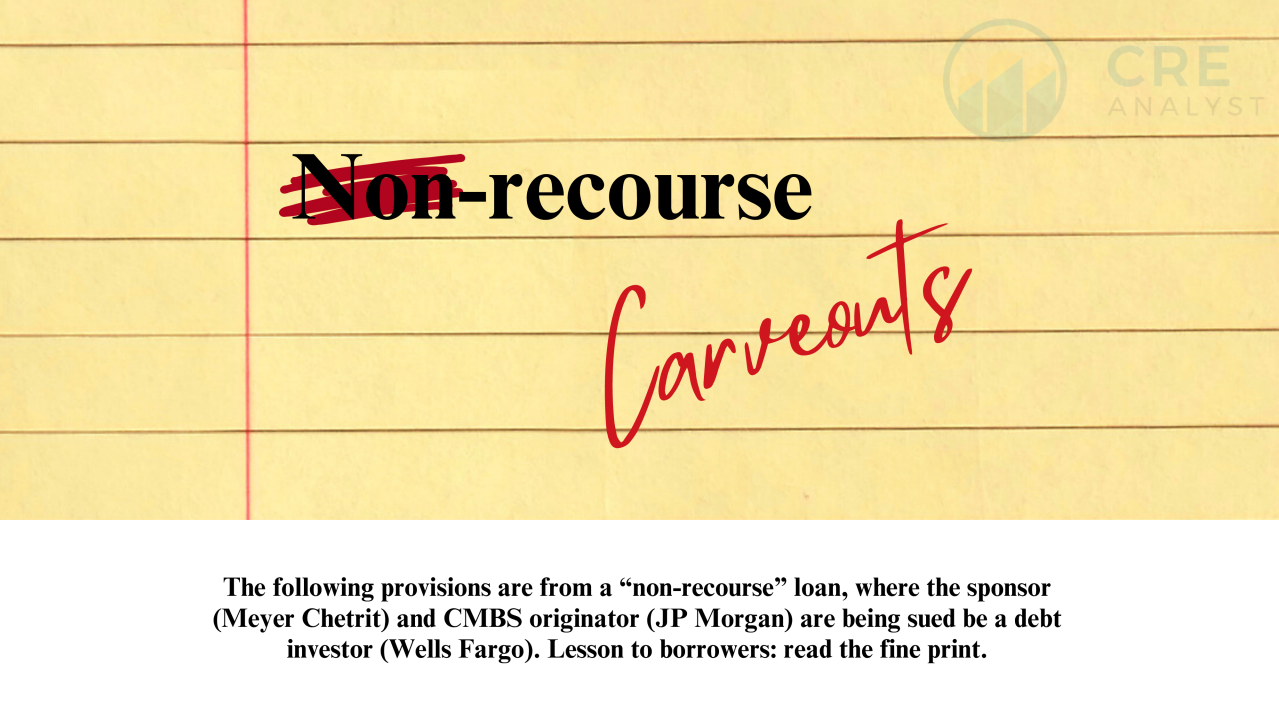
Case study: How the fine print can ruin your life...
"Representations and warranties"
"Material adverse change"
"Irrevocably and unconditionally"
"True, complete, and correct"
"Carveout guaranty"
These phrases may sound like legal jargon. 95% of the time, they’re just words on a page. But in that other 5%? The difference between surviving a problem and being owned by it is buried in the fine print.
---- A $285 million reminder ----
Last week, Wells Fargo sued Meyer Chetrit (a borrower) and JP Morgan (a CMBS packager/originator) over a $285 million claim.
Headlines focus on the lawsuit, but the real lesson? It’s in the fine print—the kind that affects every borrower, investor, and operator.
Real estate runs on four key agreements:
1. Purchase and sale agreements
2. Joint venture agreements
3. Leases
4. Loan agreements
And here’s the hard truth: "Common sense" doesn’t matter. The documents do.
For example, many assume non-recourse loans protect borrowers from personal liability. But nearly every loan document includes carveouts that can turn them into full-recourse nightmares.
Take this case. Even if the sponsor ultimately avoids a $200M+ payout, how much time, money, and energy will he and his team lose fighting it? Getting sued by a major bank is not an enviable position.
---- Our perspective ----
If legal documents intimidate you, you’re not alone. 90%+ of the real estate professionals in our courses admit they don't love reading them.
Bad news:
You can’t avoid them.
Good news:
They follow predictable patterns.
Why didn't you learn this in school?
Because it’s almost impossible to “teach” these documents in a classroom. Schools don’t have the infrastructure to create real-world deal environments, and very few instructors have deep experience across all four key agreements—let alone the ability to explain them practically.
Our unsolicited advice?
If and when you have exposure to any of these documents, don't just finish your task and slide the docs of your desk. Use your opportunities as a window for learning. Pick a few provisions, think about challenges and opportunities, and ask experienced professionals about the choke points and remedies.
Question for experienced professionals:
What are the top three provisions in loan documents that less experienced professionals should focus on?
Question for early-career professionals:
Are there any provisions you hear about or see but don't understand?
PS -- if you want to get up to speed fast, we’re enrolling for our next FastTrack cohort. We break down key documents and provide real-world frameworks to help professionals navigate deals with confidence. Forward this to anyone who might benefit or DM for details.
"Representations and warranties"
"Material adverse change"
"Irrevocably and unconditionally"
"True, complete, and correct"
"Carveout guaranty"
These phrases may sound like legal jargon. 95% of the time, they’re just words on a page. But in that other 5%? The difference between surviving a problem and being owned by it is buried in the fine print.
---- A $285 million reminder ----
Last week, Wells Fargo sued Meyer Chetrit (a borrower) and JP Morgan (a CMBS packager/originator) over a $285 million claim.
Headlines focus on the lawsuit, but the real lesson? It’s in the fine print—the kind that affects every borrower, investor, and operator.
Real estate runs on four key agreements:
1. Purchase and sale agreements
2. Joint venture agreements
3. Leases
4. Loan agreements
And here’s the hard truth: "Common sense" doesn’t matter. The documents do.
For example, many assume non-recourse loans protect borrowers from personal liability. But nearly every loan document includes carveouts that can turn them into full-recourse nightmares.
Take this case. Even if the sponsor ultimately avoids a $200M+ payout, how much time, money, and energy will he and his team lose fighting it? Getting sued by a major bank is not an enviable position.
---- Our perspective ----
If legal documents intimidate you, you’re not alone. 90%+ of the real estate professionals in our courses admit they don't love reading them.
Bad news:
You can’t avoid them.
Good news:
They follow predictable patterns.
Why didn't you learn this in school?
Because it’s almost impossible to “teach” these documents in a classroom. Schools don’t have the infrastructure to create real-world deal environments, and very few instructors have deep experience across all four key agreements—let alone the ability to explain them practically.
Our unsolicited advice?
If and when you have exposure to any of these documents, don't just finish your task and slide the docs of your desk. Use your opportunities as a window for learning. Pick a few provisions, think about challenges and opportunities, and ask experienced professionals about the choke points and remedies.
Question for experienced professionals:
What are the top three provisions in loan documents that less experienced professionals should focus on?
Question for early-career professionals:
Are there any provisions you hear about or see but don't understand?
PS -- if you want to get up to speed fast, we’re enrolling for our next FastTrack cohort. We break down key documents and provide real-world frameworks to help professionals navigate deals with confidence. Forward this to anyone who might benefit or DM for details.

COMMENTS